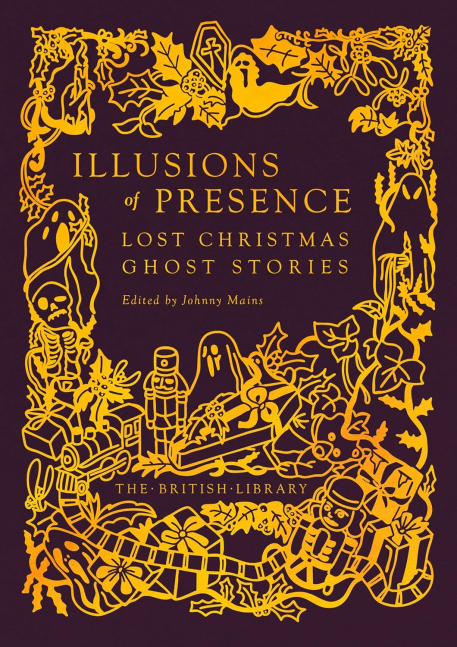
Reviewed by Tim Prasil
Christmas ghost stories, especially those written during the Victorian and Edwardian eras, have received a lot of attention from anthologists. Readers have an easy time buying a book of such material to serve as a Yuletide gift, either for someone else or for oneself. The popularity of these books might nudge one to assume the history of what Shakespeare would have known as “a winter’s tale”—a yarn about a supernatural interloper, shared fireside when the nights are colder and longer—was exclusively a Christmas practice. However, even the fussiest Victorian could not dictate when ghost stories might manifest, and there’s good evidence that they were shared at any gathering. Though he did much to link the centuries-old oral tradition of winter’s tales to Christmas specifically, even Charles Dickens set The Chimes (1844) on New Year’s Eve, as did other authors, including at least three who titled their tales “A New Year’s Ghost” (i.e. Dupree, 1881; Upshur, 1867; Wichert, 1887).
Nonetheless, Illusions of Presence: Lost Christmas Ghost Stories, edited by Johnny Mains, affirms that ghostly fiction and the commemoration of birth of Jesus truly were closely enmeshed in the late 1800s and early 1900s. In his introduction, Mains points out that those many anthologies drawing from this body of literature “have made the job of finding quality stories all the more difficult—so I’ve cast my net further afield ...” He has favored newspapers over magazines while including American and Australian sources and opening the creaky door to writers “who just tried their hand at writing a ghost story because they wanted to see if they could.” This has resulted in works ranging from well-written and genuinely creepy to, well, a bit clunky but still interesting stories.
That clunky quality is captured in this admittedly atypical line from M.E. Murray’s “The Ghost of Moor Hall” (1925): “For just one second her eyes stared widely, bluely; it was just a second—the horror lasted but a second—yet it seemed an eternity.” Ignoring the problem with a stare lasting only a second, we must consider how one accomplishes this bluely. Yet it’s exactly these moments of rough-hewn storytelling that makes Illusions of Presence distinctive and fun. Given this and the timeframe, readers should expect a bucketful of blue eyes, a hallway of haunted rooms, and, alas, only one mad-woman-in-the-attic.
Another attraction is in how this book reveals the ways that fin de siècle ghost fiction mirrors the era’s actual reports of spectral phenomena. It is a blotched and wavy mirror, to be sure, but perhaps not as distorted as readers invested in paranormal investigation today might think. Like a plume of ectoplasm, how we think about ghosts drifts, coalesces, and reshapes over time. One of the most profound shifts in such thinking during the Victorian period was marked by SPR paragon Eleanor Sidgwick (1885) in “Notes on the Evidence, Collected by the Society, for Phantasms of the Dead.” Bucking several entrenched ideas about hauntings, Sidgwick’s deep study of purportedly true reports revealed “a total absence of any apparent object or intelligent action on the part of the ghost.” A spectre “does not communicate important facts” by, for instance, providing directions to hidden wills or to treasure. If the long, long tradition of a spirit returning to convey and complete unfinished business was waning, how might fiction writers bring a strain of authenticity to their work?
Some of the authors in Main’s book simply don’t bother, opting instead to retain the old-school format of a main character deciphering the mystery of a ghostly presence and performing the work needed to allow that spirit to relinquish its worldly concerns. Emeric Hulme-Beaman’s “The Haunted Vicarage” (1903) is good example, putting a new twist on the legend of Athenodorus recorded in the letters of Pliny the Younger (61/62 CE-c. 113 CE). In place of the chain-rattling phantom who led Athenodorus to unearth its unceremoniously buried body, Hulme-Beaman employs the spirit of a suicide victim, made restless because his corpse was banished to unconsecrated ground. The story raises the issue of such people being interred as sinners—or being forgiven/unjudged prior to burial. Even a story that feels old-fashioned can be relevant to contemporary concerns.
On the other hand, some of the book’s selections leave the mystery of the spectral activity unresolved and, thereby, leaving readers unsettled. Written in semi-journalistic style, E.J. Thomas’s “Nights of Terror” (1913) describes a confusion of manifestations occurring at an Ohio house. And that’s it. Any logic lurking behind the haunting is never discerned, and the piece simply—ends. Mabel Collins, however, finds something of a compromise in “The Ghost at Red Farm” (1892). A ghost determined to protect his daughter does so with an act so traumatic, it initiates what we might term a “residual haunting,” echoing in the house for years thereafter.
Along with inviting readers to consider the stories in terms of how they reflect historical understandings of such phenomena—or understandings of hauntings in the 21st century—Illusions of Presence provides hints of the stories told fireside once upon a time. After all, many of its tales are told without the artistry of often-anthologized Christmas ghost stories, such as Charlotte Riddell’s “A Strange Christmas Game” (1868) or E. Nesbitt’s “The Shadow” (1905). (By the way, the Riddell’s tale features an apparently purposeful haunting while Nesbitt’s overtly does not.) In this way, Main’s book is both enlightening and entertaining.
References
Dupree, L. (1881). A New Year’s ghost. Ballou’s Monthly 53, 54-57.
Sidgwick, E. M. (1885). Notes on the evidence, collected by the society, for phantasms of the dead. Proceedings of the Society for Psychical Research 3, 69-150.
Upshur, M. J. (1867). A New Year’s ghost. Home Monthly 2, 58-65.
Wichert, E. (1887). A New Year’s ghost. Cosmopolitan, 305-311.

